Author Archive
 2016 Summer Trip – Day 55
2016 Summer Trip – Day 55
Wind Cave National Park, South Dakota. Devils Tower National Monument, Wyoming.

Friday, July 22nd – Toured Wind Cave. Once we entered the cave and started to descend, Emily was scared at first but then was ok. After the tour, the girls finished up their Junior Ranger books and received their badges for Wind Cave.
The day started getting hot. The expectation was temps into the upper 90s. I had gotten a prime parking spot in front of the Wind Cave Visitors Center which allowed me to connect to their wifi. I used the wifi connection to make reservations at the Devils Tower KOA. The heat made me want to camp at a location where we could make use of our air conditioner.
We left the Elk Mountain Campground around 1pm. Elk Mountain Campground is a good place to camp if the weather had been a bit more cooperative. I was disappointed in the lack of any substantial Ranger-led evening program.
It was a nice drive in a northeast direction through a national forest to I-90 where we were only on I-90 to go up one exit. Checked into Devils Tower KOA (located immediately outside the monument) and had some food across the street at the trading post. Ended up getting a pull-thru site next to another ham (KF5SA). He has an HF station mounted inside his trailer.
Quick trip up to the visitors center to get Junior Ranger books (from Ranger Erin Cahill). Attended evening program at the campground amphitheater which was blown out by bad weather into the picnic area.
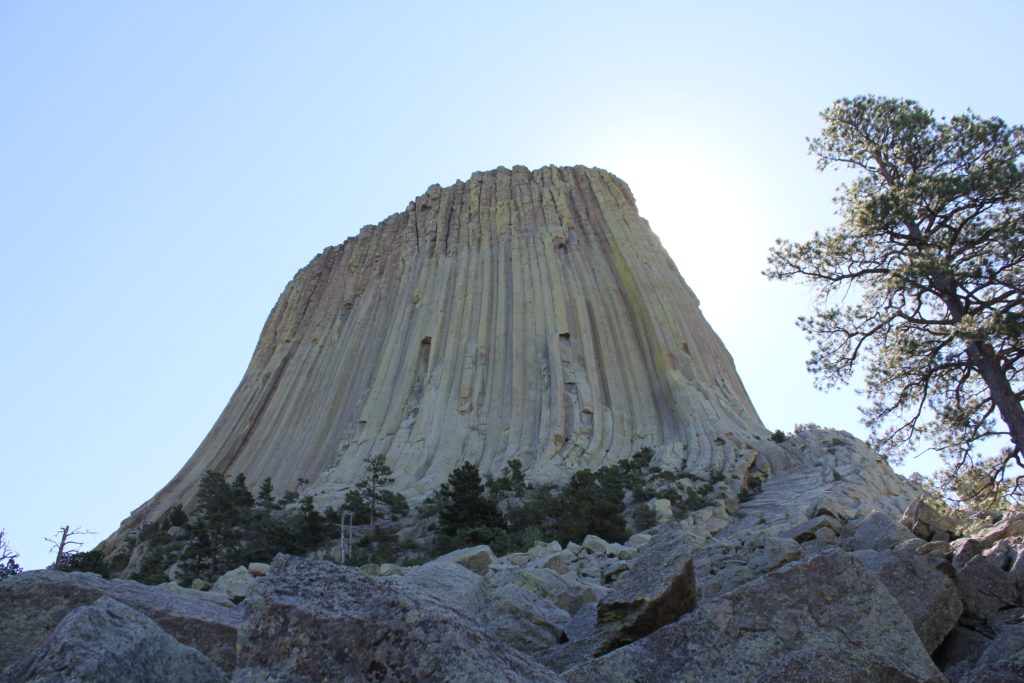
 HF Email From The Mobile?
HF Email From The Mobile?
Last summer when we were camping in the national parks, there were many campsites where we had no cell phone service. I am not complaining about that, but our work around to communicate back home to the XYL often required a trip to the pay phone (sometimes hard to find). I thought about perhaps using APRS’s capability of relaying short pieces of text as emails. Part of the problem is that there are many areas of the parks that don’t have any APRS digipeater coverage (Glacier and Yellowstone National Parks for example). How to get a message through?
Then I remembered my MARS station (AEN5AC) in Iraq. I was using an ICOM IC-7000 and an SCS PTC-IIusb modem to pass MARSGRAMS from my location north of Baghdad to another station at the US embassy in Qatar. The pairing worked quite well and I was consistently able to connect and pass traffic using PACTOR 3 at the 1400 baud rate. Could I use a similar setup to provide an HF email option while camping this summer?
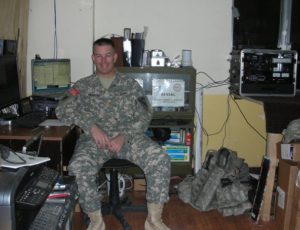
I dug out my SCS PTC-IIusb modem. I had not used it since shutting down the MARS station in June of 2008. Everything was still in the box. To include the cables necessary to interface the modem with an ICOM IC-706MKIIG… the same rig I use for HF mobile.
I pulled out my spare IC-706MKIIG. Coming back to Kansas from Field Day in California back in 2009, my IC-706MKIIG quit on me. I ended up buying a second at the HRO in Denver and sent the broke one to ICOM. ICOM fixed it and returned it. I kept it in the box and it went back on the shelf. I did order a 6 pin Molex connector with powerpoles to allow for an easy power connection (#9). I connected the two cables from the modem to the rig. Once cable is for the data and plugs into the 706’s 13 pin accessory connection (#4). The other cable connects to the 706’s CI-V interface (#6) to have the radio change frequencies based on what station is being contacted.
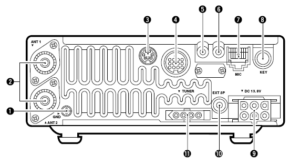
I had the basic hardware of a HF email station, except for a computer. I would need one that would function out of the vehicle. This would probably require a laptop. I also decided for the ease of simplicity that the computer should be Windows driven (instead of Linux). Gasp! The bottom line is that the software and drivers required to send email via HF and use the SCS PTC-IIusb modem is Windows based. The answer ended up being an Dell XPS 15.

Using a Windows based computer helped me with a number of summer travel tasks that could not be accomplished by my small Linux laptop:
(1) Run the software required for HF email (more on Winlink and Airmail later)
(2) Run ARRL’s TravelPlus for Repeaters
(3) Run RT Systems radio programming software for my TM-D710A
(4) Run RT Systems radio programming software for my VX-8RGs
(5) Read the SD card from my Canon digital camera
Interestingly enough, the new laptop does not have a CD/DVD drive nor an RJ-45 connection for a LAN cable. Neither of these have been a show stopper yet.
ARRL’s TravelPlus for Repeaters
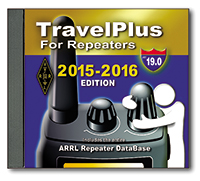 I had purchased TravelPlus for Repeaters with the intent of installing it on my existing Linux laptop and running it under a VirtualBox Windows session (similar to how I run iTunes on my Linux laptop). However the software failed to install. I tried troubleshooting and looking at suggested fixes found on the forum sites but still had no luck. I tried installing TravelPlus using WINE. It installed but would not run as well.
I had purchased TravelPlus for Repeaters with the intent of installing it on my existing Linux laptop and running it under a VirtualBox Windows session (similar to how I run iTunes on my Linux laptop). However the software failed to install. I tried troubleshooting and looking at suggested fixes found on the forum sites but still had no luck. I tried installing TravelPlus using WINE. It installed but would not run as well.
Dell XPS 15 to the rescue. As the laptop does not have a CD/DVD drive, I copied the drive onto network storage. I then was able to install TravelPlus over the network and it is working without issue.
RT Systems Programming Software
The RT Systems programming software works fine under a VirtualBox Windows session. As I was moving all my vehicle related radio/computer tasks to the new Windows laptop, I attempted to install the programming software for the TM-D710A (used for beaconing the location of my vehicle and talking on VHF/UHF). Following a similar procedure that worked for TravelPlus, I copied the programming software from the install disks to a network drive. The software installation for the TM-D710A worked without a hitch. The software for the VX-8RGs (HTs we use for around camp and hiking) failed to load. The error said that I must use the original disk to install. A big challenge when the laptop doesn’t have a CD/DVD drive. The work around is that you find another Windows computer with a CD drive, load the software CD, then back on the driveless laptop, map the CD drive (like you would map a network drive). That worked and I was able to install the programing software for the VX-8GR.
HF Email Software
There are two main choices for software to allow for HF email: RMS Express and Airmail. I installed both. Airmail was the same program I used in Iraq and it offered easy configuration with the IC-706MKIIG and the SCS PTC-IIusb.
I now had all my equipment for a test run setup in my basement hamshack: spare IC-706MKIIG, SCS PTC-IIusb, and the Dell XPS 15 with Airmail. I connected the IC-706MKIIG to my Elecraft tuner and used my existing G5RV antenna. Airmail configures easily. The software has a list of stations offering mailbox services that can be viewed on a propagation chart by frequency and distance. Based on time of day, I selected a station in Texas that offered a 40M PACTOR 3 connection. Airmail allows me to click on the frequency in the propagation chart which then changes the dial frequency of the radio. After listening to see if there were any ongoing connections, I initiated contact. The modem lights flashed and the rig clicked between transmit and receive. The connection was made and I was able to send a test email as well as a position report.
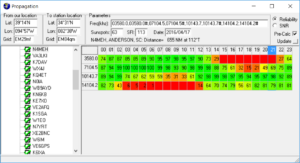
Success! The position reports that go into the Winlink system are copied over into APRS. Now, even if I am not able to reach a digipeater with my VHF APRS beacon, I can send a position report over HF to let the XYL know where we are.
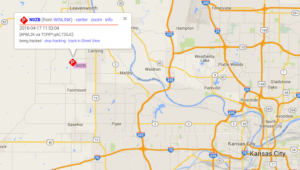
I then thought about the steps I would have to take of transitioning my IC-706MKIIG configured for HF mobile to be ready to work with the PTC-IIusb to send email. As the remote head is located up near the drivers seat, this would present problems with being able to observe the modem, laptop, and radio control head all at the same time.
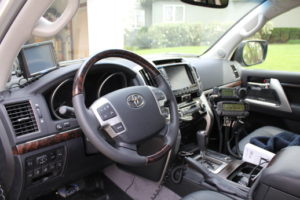
What if I just dedicated the spare IC-706MKIIG rig to the task of HF email? It would save me time and bother in pulling and plugging cables. It would also give the camping option of being able to operate HF from outside the vehicle.
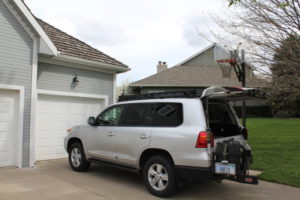
Using an additional iPortable box, I rack mounted the spare IC-706MKIIG and the SCS PTC-IIusb. Now I will have a spare HF rig with me, so if one goes out I will still be operational. I also attached the Tarheel screwdriver antenna’s rocker switch to raise and lower the antenna on the side of the box. During normal HF mobile operations, the TurboTuner (connected to the other IC-706’s tuner connection and CI-V connection) manages achieving a correct match between the operating frequency and the screwdriver antenna.
I only have the one TurboTuner. The TurboTuner requires a connection to the CI-V. So does the SCS PTC-IIusb. My solution was to leave the TurboTuner alone. Instead, using the rocker switch, I can manually tune the antenna while visually observing the 706’s SWR meter.
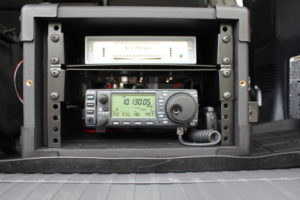
To transition between using the 706 dedicated to HF mobile to the 706 now dedicated to HF email, I have to do the following:
(1) disconnect the antenna feedline from the TurboTuner
(2) disconnect the control line that goes from the TurboTuner to the Tarheel screwdriver antenna
(3) connect the antenna feedline directly to the HF email 706
(4) connect the control line to the rocker switch
(5) connect the laptop to the SCS PTC-IIusb via a USB cable
(6) connect the iPortable’s powerpole connection to the junction box in the back of the vehicle
… then I am ready to go. The iPortable box rests nicely on the vehicle’s tailgate, next to the laptop. All at about lawn chair height. Not only can I use this setup to send email via HF, but I can also use it for causal National Parks On The Air contacts as well.
What’s left to do:
(1) Constant cooling fan modification for both IC-706s (see AD5X’s article)
(2) An extended control cable for the Tarheel screwdriver antenna. This will allow me to further remote away from the vehicle, but still use the antenna.
(3) A length of antenna feedline for remoting.
(4) A length of powerpole-ready powerline to attach to either the travel trailer battery or directly to the spare vehicle battery… again for remoting away from the vehicle.
(5) I have a set of Heil headsets that worked with my IC-7000. I think if I get the AD-1ICM, I should be able to use them with the 706.
(6) A Heil HS-2 hand PTT switch to use with the headset.
 The FCC says you have a new callsign. Now what?
The FCC says you have a new callsign. Now what?
Once I knew that I had a new callsign, I sat down a wrote down a list of what I needed to do…
(1) QRZ.com website. When my callsign changed a few years back from AD7MI to NI0L, I jumped on the air to “test it out”. On 20m, I was having a PSK31 QSO when the distant party thought I was a pirate station because on QRZ.com my new callsign did not reflect the name and QTH I was using. A pirate! I explained that it was a new callsign but I could tell that the other guy was not buying it.
I thought I would need to go on to QRZ.com and register as a new user. I made a posting in the QRZ.com forum category dedicated to callsign problems. The end result: just wait… the change will take place automatically in a few days.
And that is the case. If you are a US ham and change your callsign, just wait. Within two or three days the callsign change will be reflected on QRZ.com. If you get on the air before QRZ.com is updated, be prepared for people to think you are a pirate.
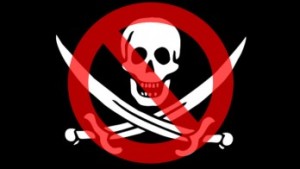
(2) Log of The World. Easy to do. Just submit for a new certificate under the new callsign. ARRL usually responds within one working day.
(3) EchoIRLP node. This ended up being much easier than I thought it would be.
a. To change your callsign in the IRLP database, go to this webpage using a computer connected to the same router as the IRLP node.
b. Go into your node and edit irlp/custom/environment file to change the old callsign to the new callsign. Restart the node and verify the changes have taken effect.
c. For the EchoLink side:
– Validate your new callsign.
– Check for validation of the new EchoLink call sign / node number on EchoLink using the EchoLink PC client software. Remember, EchoIRLP only allows link (-L) or repeater (-R) nodes.
– Note: you can only register the new callsign once the EchoLink folks of pulled the latest and greatest database update from the FCC. This may take a day or two. Once that is done, you can validate your new callsign. Your new callsign will be assigned a new EchoLink node number. If you want to use your previous node number, EchoLink allows you to swap node numbers between your old callsign and your new callsign.
– Once you are validated and have swapped node numbers edit the files and settings listed below:
/home/EchoIRLP/ custom/tbd. conf
ConferenceCall =
ConferencePass =
/home/EchoIRLP/ custom/echo_ environment
export ECHO_MYCALL=
/home/EchoIRLP/ custom/userdata. txt
Restart IRLP from root login with script /home/irlp/custom/ rc.irlp, or reboot the node.
IRLP node 4433 and EchoLink node 536398 are up and operational.
(4) APRS – change the callsign in my vehicle, HTs, and UI-View32. Pretty straight forward. The home weather station info can now be found here.
(5) Change the blog website. I have been keeping an amateur radio blog for about 10 years now. Web hosting companies make it pretty easy to get a domain for your website and then setup web hosting. I like using WordPress to setup and maintain the actual blog. Fairly straight forward but flexible to do just about anything you would want for a amateur radio blog. The new website is up and running.
(6) Callsign license plate. Kansas makes the pretty simple. I went down to my county office on Friday after work. The application process was smooth and the wait should be about 4-6 weeks.
(7) New QSL card. I am thinking of going with this:
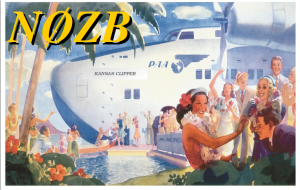
 NI0L…. Happy Trails!
NI0L…. Happy Trails!
I have a new, bright, and shiny callsign!
When I made the decision back in 2013 to stay in Kansas after retiring from the military, I decided I would try to get a callsign for zero-land (or ten-land, if you like). It was time to leave my 7-land callsign and fully embrace being a citizen of the sunflower state. NI0L was available and I applied for it without much thought. After having the callsign for a while, I noticed many hams were confused with the 2×1 call. The most common mistake was flip flopping the zero and the “i”. Another common mistake was interpreting the “i” as one and then the zero would become an “o” (N1OL). All very confusing.
The hunt for a new callsign was on. I determined that a new callsign would still be from zero-land, thus greatly reducing the pool of available calls. In an effort to avoid callsign confusion, I further resolved that the call would be a 1×2 call. The good news was that the vanity callsign fee was no more. The bad news was that everybody and their brother was applying for vanity calls. For the last few months I kept at it – watching which calls became available and then submitting applications. Waiting. The odds where never in my favor. Often there would be 10 or twelve applying, all in competition.
Perseverance finally paid off. Last week the FCC said that I was now the proud holder of N0ZB. It is a 1×2 call, that should alleviate some confusion. The “zero” and the “zulu” may prove to be a bit of a tongue twister, but I think it will be far less of an issue and having the “zero” and an “i” next to one another.
 NI0L…. Happy Trails!
NI0L…. Happy Trails!
I have a new, bright, and shiny callsign!
When I made the decision back in 2013 to stay in Kansas after retiring from the military, I decided I would try to get a callsign for zero-land (or ten-land, if you like). It was time to leave my 7-land callsign and fully embrace being a citizen of the sunflower state. NI0L was available and I applied for it without much thought. After having the callsign for a while, I noticed many hams were confused with the 2×1 call. The most common mistake was flip flopping the zero and the “i”. Another common mistake was interpreting the “i” as one and then the zero would become an “o” (N1OL). All very confusing.
The hunt for a new callsign was on. I determined that a new callsign would still be from zero-land, thus greatly reducing the pool of available calls. In an effort to avoid callsign confusion, I further resolved that the call would be a 1×2 call. The good news was that the vanity callsign fee was no more. The bad news was that everybody and their brother was applying for vanity calls. For the last few months I kept at it – watching which calls became available and then submitting applications. Waiting. The odds where never in my favor. Often there would be 10 or twelve applying, all in competition.
Perseverance finally paid off. Last week the FCC said that I was now the proud holder of N0ZB. It is a 1×2 call, that should alleviate some confusion. The “zero” and the “zulu” may prove to be a bit of a tongue twister, but I think it will be far less of an issue and having the “zero” and an “i” next to one another.
 The Day The Computer Died
The Day The Computer Died
I have been using small footprint computers in ham shack for a while. It started with the Dell Zino. Always a bit under powered, but enough to get the hamming done. The latest computer driving everything was one of those barebones models that was the size of a shoe box. The first sign of decline was when the fan kept getting louder and LOUDER. The the drive (500GBs of SATA) then decided to give up the ghost.
An immediate lesson learned… back up my log. I have been good at uploading my logs (almost daily, when on the air) to LOTW, QRZ.com, and eQSL. But I would only export that days contacts, consistently replacing the previous days exported log.
I choose not to abandon the small footprint computer and went back to the Shuttle. Newegg.org was my one stop shopping:
The case and motherboard: Shuttle XH81 Intel Core i7 / i5 / i3 / Pentium / Celeron 65W Intel H81 1 x HDMI Barebone system
– small form factor, fits neatly underneath monitor.
– 2x RS-232 connections on the back. Perfect for connecting to the Elecraft amp and tuner.
– Plenty of USB connections
Intel Core i7-4770S Haswell Quad-Core 3.1 GHz LGA 1150 65W BX80646I74770S Desktop Processor Intel HD Graphics
– not the fastest, but fast enough.
– comes with a super quiet fan.
Transcend JetRam 8GB 204-Pin DDR3 SO-DIMM DDR3 1600 (PC3 12800) Laptop Memory Model JM1600KSH-8G
– I got two DIMMs to keep things moving… 16GBs = snappy!
SAMSUNG 850 EVO 2.5″ 250GB SATA III 3-D Vertical Internal Solid State Drive (SSD) MZ-75E250B/AM
– Good bye disk, hello solid state. Faster. Silent.
The actual build was plug and play. The Shuttle line has come a long way since my last experience with their product. I think these specific computers are designed to operate older types of technology (hint…. 2x RS-232 connections?) which works great with most amateur radio needs.
The next step was loading the OS. LiLi USB Creator is my go to solution for installing linux when I don’t have an optical drive (which is more often the case). This allows you to load the OS through booting directly from the USB stick.
The linux flavor of the day: Mint with the MATE edition. I was an Ubuntu man until Unity. Then made the jump to Mint. The OS loaded without issue and I was off and running.
Amazingly enough, I was able to install TQSL-2.2. In the past, I have been able to install TQSL from the Software Manager. But this has been an older version of TQSL. The newer versions ALWAYS gave my problems with dependency issues during attempted installs. I stayed with it this time and finally got it working. Phew!
The install of fldigi went smoothe, but configuring it to work with my Elecraft K3 was giving me fits. In my past setup, I’ve always used hamlib for rig control and the trick was just finding which USB number was being used for my USB Microham III. But this time, the USB Microham III was identified by name as a choice. Great! But it didn’t initialize. I tried USB0 (…. nothing), combed over the results of lsusb…. not… working. After some intense Googling, I ran across a command I had never seen before:
sudo adduser [username] dialout
Dialout!? Who knew? But that did the trick.
Now, here is something funny. We all have our junk boxes. As hams, we are pack rats. We hang on to stuff that has no current use, but may someday. I had a box RS-232 cables. When Fall Cleaning swept through the ham shack, I looked at the RS-232 cables. I am really going to need 15 RS-232 cables ranging in length between two and 15 feet? The box headed to the dump.
Now, with my growing K-Line, I can use Elecraft software (linux versions available) to monitor data from the amp and tuner. But the connections are serial. SERIAL. I turned the ham shack upside down and not an RS-232 cable to be found. I really don’t want to have to actually go out and BUY a serial cable.
 NPOTA: ARRL’s Best Idea?
NPOTA: ARRL’s Best Idea?
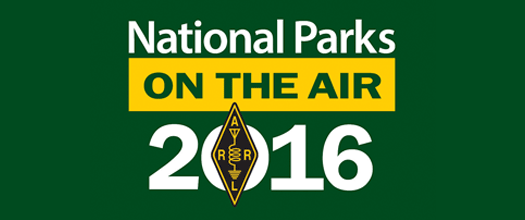 The National Parks on the Air (NPOTA) is off and running. Making contact with a handful of stations currently operating from NPOTA locations has made me wonder if the ARRL has had a good idea with NPOTA as a way to help celebrate the anniversary of the National Park Service.
The National Parks on the Air (NPOTA) is off and running. Making contact with a handful of stations currently operating from NPOTA locations has made me wonder if the ARRL has had a good idea with NPOTA as a way to help celebrate the anniversary of the National Park Service.
From ARRL: “Throughout 2016, Amateur Radio will be helping the National Park Service celebrate their 100th anniversary. Hams from across the country will activate NPS units, promote the National Park Service and showcase Amateur Radio to the public.”
I am a huge fan of both the National Parks and the National Park Service. Anyone who is interested in the history of our National Parks would be well rewarded to start with the Ken Burns documentary The National Parks: America’s Best Idea. Yellowstone generally gets credit for being the first National Park back in 1872. However, the National Park Service was not established until 1916. That period in between provides us a very good reason that there are times when we need a government organization to protect us from ourselves. During that in between period, the Army was given the mission of attempting to protect both Yellowstone and Yosemite. Like most missions the Army received, they were underfunded, under equipped, and undermanned. They did, however, do the best they could to protect these amazing areas. Many Americans saw these new National Parks as areas for economic exploitation. If it wasn’t for many individuals working long and hard for the establishment of the National Park Service, it is very likely we would not be able to enjoy the parks we have today. Stephen Mather and Horace Albright were the two primary individuals who secured the establishment of the National Park Service. Ken Burns talks about these two individuals in his documentary and there are also a few books that do a great job telling the story (Creating the National Park Service: The Missing Years and The Birth of the National Park Service: The Founding Years, 1913-33).

The National Parks exist for our enjoyment. Generally that enjoyment manifests itself in some type of hiking, camping, fishing, watching for wildlife, or learning about history. This interaction between Park and citizen can be passionate, emotional, revitalizing, inspirational, and an educational experience.
With all that being said, I was a bit surprised to hear stations making contacts for NPOTA locations like it was a contest. Each NPOTA location is identified by a letter-number combination. No discussion of where they actually were. No description, no discussion. It is a bit sad to see there is a Leader Board – which only facilitates looking at NPOTA as a contest rather than an actual celebration.
I also wonder how these activations are impacting those non-amateur radio enthusiasts who are visiting a NPOTA site. Is this putting amateur radio in the best light?
Are these NPOTA activations promoting the National Park Service or showcasing Amateur Radio to the public?
If so, how?
What would Stephen Mather and Horace Albright think about NPOTA?
It will be interesting to see how NPOTA progresses over the coming weeks and months.











